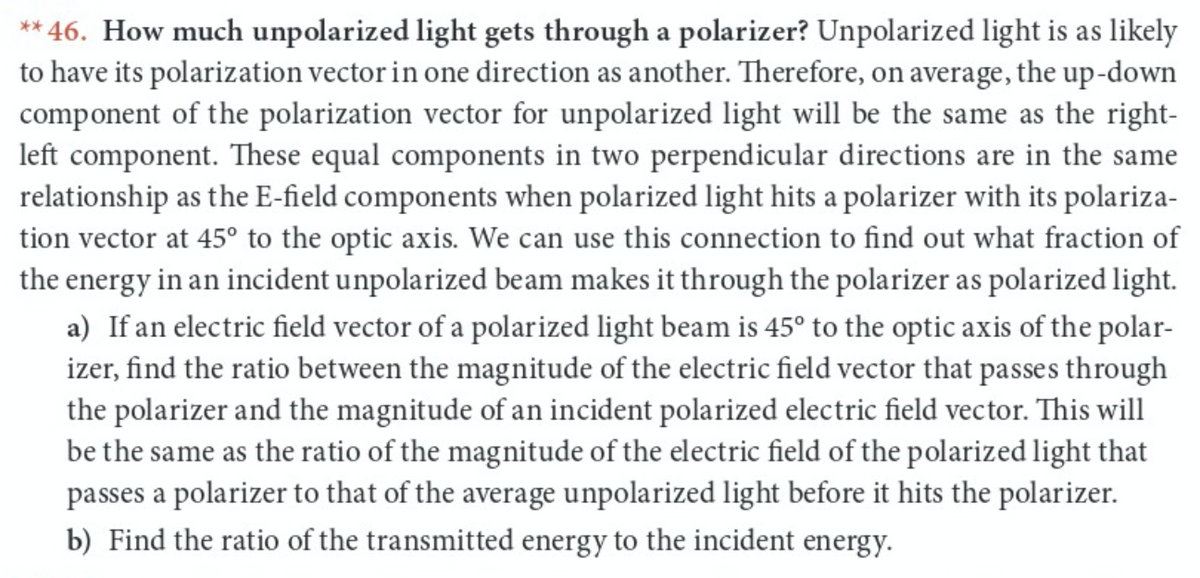** 46. How much unpolarized light gets through a polarizer? Unpolarized light is as likely to have its polarization vector in one direction as another. Therefore, on average, the up-down component of the polarization vector for unpolarized light will be the same as the right- left component. These equal components in two perpendicular directions are in the same relationship as the E-field components when polarized light hits a polarizer with its polariza- tion vector at 45° to the optic axis. We can use this connection to find out what fraction of the energy in an incident unpolarized beam makes it through the polarizer as polarized light. a) If an electric field vector of a polarized light beam is 45° to the optic axis of the polar- izer, find the ratio between the magnitude of the electric field vector that passes through the polarizer and the magnitude of an incident polarized electric field vector. This will be the same as the ratio of the magnitude of the electric field of the polarized light that passes a polarizer to that of the average unpolarized light before it hits the polarizer. b) Find the ratio of the transmitted energy to the incident energy.
** 46. How much unpolarized light gets through a polarizer? Unpolarized light is as likely to have its polarization vector in one direction as another. Therefore, on average, the up-down component of the polarization vector for unpolarized light will be the same as the right- left component. These equal components in two perpendicular directions are in the same relationship as the E-field components when polarized light hits a polarizer with its polariza- tion vector at 45° to the optic axis. We can use this connection to find out what fraction of the energy in an incident unpolarized beam makes it through the polarizer as polarized light. a) If an electric field vector of a polarized light beam is 45° to the optic axis of the polar- izer, find the ratio between the magnitude of the electric field vector that passes through the polarizer and the magnitude of an incident polarized electric field vector. This will be the same as the ratio of the magnitude of the electric field of the polarized light that passes a polarizer to that of the average unpolarized light before it hits the polarizer. b) Find the ratio of the transmitted energy to the incident energy.
Related questions
Question

Transcribed Image Text:** 46. How much unpolarized light gets through a polarizer? Unpolarized light is as likely
to have its polarization vector in one direction as another. Therefore, on average, the up-down
component of the polarization vector for unpolarized light will be the same as the right-
left component. These equal components in two perpendicular directions are in the same
relationship as the E-field components when polarized light hits a polarizer with its polariza-
tion vector at 45° to the optic axis. We can use this connection to find out what fraction of
the energy in an incident unpolarized beam makes it through the polarizer as polarized light.
a) If an electric field vector of a polarized light beam is 45° to the optic axis of the polar-
izer, find the ratio between the magnitude of the electric field vector that passes through
the polarizer and the magnitude of an incident polarized electric field vector. This will
be the same as the ratio of the magnitude of the electric field of the polarized light that
passes a polarizer to that of the average unpolarized light before it hits the polarizer.
b) Find the ratio of the transmitted energy to the incident energy.
Expert Solution
This question has been solved!
Explore an expertly crafted, step-by-step solution for a thorough understanding of key concepts.
This is a popular solution!
Trending now
This is a popular solution!
Step by step
Solved in 2 steps
